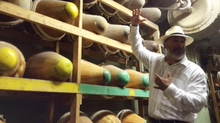The Next Page: #Them too — women who toiled in steel mills faced their own harassers
Blue-collar women faced abuse long before a series of sexual harassment scandals shined a light on white-collar predators
Ask any woman if she’d return to her job as a steelworker during the 1970s and ’80s, and she’d say yes in a nanosecond, even while describing the daily fear of being maimed or killed. Women felt empowered doing men’s work, earned better money than pink-collar wage earners and even loved the steel plants for their hypnotic dangers. “I always felt I was watching a high-wire circus act,” one woman told me.
But ask the same women about workplace sexual dynamics during that era, and their answers range from the “mills were all sex, sex, sex” to cautious judgments that men were “too friendly.” There was also one woman who told me, with a laugh, “I couldn’t even tell a man from a woman because we all wore heavy overalls, wool caps and safety glasses.”

I tracked down a dozen women who have worked in Pittsburgh steel plants because a spate of sexual harassment cases involving high-profile men in government, business and entertainment made me wonder about blue-collar women on factory floors.
After Rosie the Riveter returned home at the end of World War II, female steelworkers were scarce. The female production force of 700 workers at U.S. Steel’s Duquesne Works, for example, was reduced to 125 by June 1946. These numbers stayed the same until 1974, when a national consent decree required steel companies to hire women and minorities in jobs with better wages, health care packages and opportunities for promotion.
But these upgrades did not guarantee a hospitable reception for women breaking into a man’s world.
At a union hall in Homestead, an oldtimer didn’t want others to overhear him tell me, “Women worked hard … wore hard shoes. I always felt sorry for what they were up against.” A big change for him in 1974 was that men no longer felt “free to pee wherever, whenever, they wanted.”
Caroline Pressley was a 32-year-old divorced mother of two, living below the poverty line, when the Homestead Steel Works posted a sign seeking new workers in the spring of 1977.
“Pornographic magazines were all over the place, then guys would ogle and compare you as you walked by,” she said.
Her first day on the job, Caroline saw a woman faint on the plant floor. She said “guys pounced on her like vultures and ripped open her shirt and exposed her breasts. That wasn’t ever going to happen to me.”
From then on, Caroline wore a thick leotard underneath her long johns, denim trousers and leather apron.
Statuesque at 72, Caroline erupted into gales of laughter at Panera in Oakmont as she remembered how a grizzly steelworker twice her age tried to lure her into an ashpit where he had created a secret bower with layers of greasy rags. “I told him I wanted to be cute for him, so why didn’t he pick me up some night at home. He backed off.”
Stories are legion about holes drilled into women’s locker rooms for easy spying, as most showers were without curtains or stalls. Even after women were hired in 1974, men still cleaned the women’s bathrooms and sometimes locked the doors to grab a nap, denying women their only private space.
Men exposing themselves in the shadows were part of the scenery. On the production floor, gropings were so swift, they felt almost innocent. Sexual profanities were background noise and more creative than even Falstaff could make up. Some women say pervasive fog made it impossible to tell a man from a woman, but others claim steam was a perfect cover for inappropriate behavior in a shrouded corner.
Because the mills were noisy with clanging metal and piercing sirens, workers used hand signals to communicate maneuvers involving dangerous equipment. Cooperation was especially necessary between crane operators in the air and their “hookers” on the floor who were responsible for attaching plates of steel to the crane’s chains for safe transport to other parts of the mill.
One hooker new to the job could hardly believe her ears when a crane driver waved aside her silent gestures and, using a crude analogy, yelled for her to adjust the steel plate only slightly. She repeated the command as expected, because, if not, she’d face more ugly challenges.
Another woman on the floor, Alice Casey, has no memory of being bullied in the Homestead plant during the ’70s, except when a steelworker stepped out of the gloom to whisper that she should be at home having babies. Circling a finger around her temple, she signaled to her crane operator that the guy was nuts.
“The mill was a different world, more exciting than you can ever imagine with the color and sounds,” she recalled. But even better was a $350 paycheck twice a month that allowed her to buy presents for her niece and take some nice trips. After being laid off from Homestead in 1981, Alice cleaned houses.
Unlike Alice, other women endured public cruelties deserving community support. Rather than register grievances with their foreman and risk backlash, they confided in each other. “The locker room was my Dr. Phil,” said a woman recalling her days working on the labor gang at Homestead.
Early on, she was ordered to descend into a 6-foot pit to shovel out tar-like grease, oily rags and newspapers dating to before World War II. The task was a charade to test her endurance, but the divorced mother met the challenge because of a desire to lift her family out of poverty. Another time, she had to climb a ladder three stories, while being taunted all the way, to scrub the roof of a small tool shed that hadn’t been used in years and wouldn’t be again any time soon.
Seeing the need for female solidarity, Steffi Domike, an electrical apprentice at U.S. Steel’s Clairton Works, organized Women of Steel, an activist group for women in Pittsburgh plants. One of the most unusual women to benefit from the consent decree, Steffi graduated from Reed College in 1976 as an economics major. She came east from Oregon to Pittsburgh because she wanted to learn about the U.S. labor movement from inside. As she noted, “Pittsburgh is the historic center.” Now she is a labor educator with the United Steelworkers.
In a 1978 Women of Steel newsletter, women were coached to walk a delicate line between pushing back and getting along with male co-workers: (“Hey, do you fool around?” “I don’t fool around. I play for keeps and I don’t think you can handle it.”)
But more important, Women of Steel opened the door for the USW to discuss maternity coverage, safety, job training and full disclosure of hiring and firing of women. Women of Steel tried to pump up the working rights of women before the retrenchment of the steel industry occurred, because women would be the first to be laid off because of low seniority.
To show women succeeding in non-traditional jobs so that they would not have to return to low-paying service jobs, she and three other steelworkers, Beth Destler, Allyn Stewart and Linny Stovall, produced the “Women of Steel” documentary in 1983. One of the women featured in the film, Pat Turnell, landed a job as a laborer on a railroad track for U.S. Steel in 1976. Within six years, she was a boilermaker apprentice, earning $23 an hour. “I was just at the point where the guys on the gang treated me like a person … and then it was all wiped out,” she said, referring to the industry’s nosedive.
Today, blue-collar women are not left on their own to confront workplace inequalities. The USW requires each district to have a women’s committee to raise awareness of working women’s issues and increase female activism in the union and community. “Women still have their own issues, like health and safety. Gender-based violence is a health and safety issue,” says Alice Flener, director of the USW Women of Steel. Her goal is for blue-collar women across the country to enroll in an interdisciplinary Women of Steel leadership course, offered at the union’s Pittsburgh headquarters, over three- to five-day periods.
For Jaimee Grinage, USW safety representative for the Galvanize Department at U.S. Steel’s Irvin Plant, the history of women in the steel industry is the most important segment of the leadership seminar.
As a child, she remembers her mother, Caroline Pressley, a millwright helper, coming out of the Homestead plant “smelling of fire and ash, and she’s always been an inspiration for me. I don’t know where we’d be without women of her generation — how they spoke up to bring about change. I don’t know if any of us would have the guts to be one of them.”
At the end of their shifts at Irvin, I sat in a spartan office in the West Mifflin union hall, with Jaimee and Keli Vereb, a caster scheduler in business planning from USW Local 2227 and coordinator of Women of Steel in District 10, which encompasses all of Pennsylvania. “Those are the women whose shoulders we stand on,” Keli agreed. “I can’t imagine how they endured such an unwelcoming environment, day after day.”
Rosie the Riveter is a national icon, but women steelworkers between 1974 and 1984 were the real deal.
Ellie Wymard, Ph.D. (Ebwymard@aol.com), is the retired director of Carlow University's graduate program in creative writing and the author of four books, including “Talking Steel Towns: The Men and Women of America’s Steel Valley.”





















